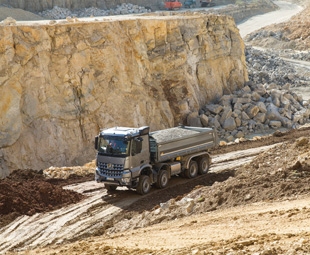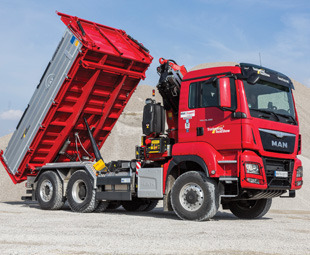Do you need to tip your tipper?

End-tipping truck bodies are very often overloaded, used in the incorrect application and not properly maintained, explains VIC OLIVER
End-tipping bodies are prone to overloading. This is mainly as a result of the operator and driver not understanding that the mass per cubic metre of the material being loaded must be taken into consideration when determining how much is to be loaded into the tipper. A good example that illustrates the problem is the two-cube, end-tipping body.
These small end-tipping bodies are normally fitted to a truck chassis that has a limited permissible payload capacity of approximately 2 000 kg. The average density of dry sand is 1 600 kg per cubic metre; therefore a full load would overload the truck by 1 200 kg.
Often the load is heaped up higher than the sides of the vehicle, which aggravates the problem. If the unit were to be fully loaded to its designed cubic capacity with wet river sand, which has a density of 2 000 kg per cubic metre, it would be grossly overloaded.
The same problem applies to the bigger end-tipping bodies. To eliminate the problem, operators and drivers must know the density of the material that they will be transporting and adjust the load according to the permissible payload capacity of the truck.
Standard end-tipping bodies are designed for the conveyance of sand, gravel and crushed stone and not for the transport of heavy rocks and corrosive materials.
Loading and transporting heavy rocks and corrosive materials will quickly destroy a standard end-tipping body as the floor is constructed from five-millimetre mild steel and the sides and headboard from three-millimetre mild steel – which cannot withstand the impact of heavy rocks.
 Truck body builders that specialise in the building of good end-tipping bodies have a range of heavy-duty designs for tippers that can be used to transport heavy and corrosive materials. These are commonly called “rock dumpers”.
Truck body builders that specialise in the building of good end-tipping bodies have a range of heavy-duty designs for tippers that can be used to transport heavy and corrosive materials. These are commonly called “rock dumpers”.
Often the tailgate on a standard end-tipping body is removed to allow a bulky load to discharge quickly. Removing the tailgate will soon result in the sides of a standard tipper body collapsing and destruction of the tipper body, as the tailgate is hinged at the top of both sides and acts as a support structure to hold the sides of the body from splaying.
In the current tough economic operating conditions in which many road transport fleet companies have to compete, vehicle up time (the daily availability of the vehicle) is a critical factor, which cannot be achieved if truck bodies are not well maintained.
Sadly, the proper maintenance of end-tipping bodies is neglected in many South African fleets. Many truck operators do not realise that maintaining their truck bodies in good condition is a vital function that contributes to maximising vehicle productivity and safety, and reducing the risk of costly roadside breakdowns.
Preventative maintenance of tipper bodies is both desirable and necessary. It consists of those routines that keep the equipment in proper working condition.
Routine inspection will ensure continued trouble-free operation of the equipment and prevent – or at least detect at an early stage – mechanical or hydraulic problems that might otherwise develop into equipment failures. For example, all hinges and driveline bearings should be greased daily.
As part of a monthly routine, the following maintenance should be undertaken:
• Check all bolts for tightness – pay special attention to the U bolts securing the sub frame to the chassis;
• Check the power take-off driveline;
• Check oil lever for the correct level;
• Check colour of the oil for contamination.
Not overloading your end-tipping body, using it in the right application and maintaining it well will give you many years of trouble-free usage.
What’s trending overseas?
German manufacturer Kögel, one of the leading trailer manufacturers in Europe, exhibited ten of its latest trailer designs at the IAA Commercial Vehicles show during September.
According to the company, the products and ideas it exhibited made a major contribution to solving the logistic tasks of both the present and future, and are driving the industry forward.
Star of the show was the brand-new Kögel Light plus, with its weight-optimised frame and body for an optimised payload. The universal Kögel Cargo Rail with FlexiUse structure and RoRo equipment was also shown. This is a curtainsider for road, ship, and rail with new double codification.
Another interesting vehicle was the Kögel Port 40 Simplex: Saddle-container chassis with rear extension for transporting 20, 30, and 40-foot ISO containers, or one 40-foot high-cube container. Similarly, the company’s Kögel Mega features a new stacker storage and equipment variant, for double-level loading in the automotive sector of equipped mega-trailers.
The Kögel three-axle asphalt tipper trailer features a fully insulated thermal recesses and self-steering axle. Finally, Kögel Telematics combines a trailer telematic module and Kögel telematic web portal for more transparency in the supply chain.
One of this country’s most respected commercial vehicle industry authorities, VIC OLIVER has been in this industry for over 50 years. Before joining the FOCUS team, he spent 15 years with Nissan Diesel (now UD Trucks), 11 years with Busaf and seven years with International.
Published by
Focus on Transport
focusmagsa




